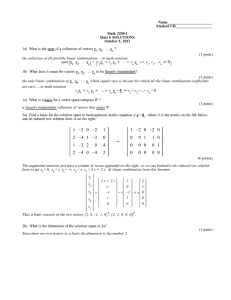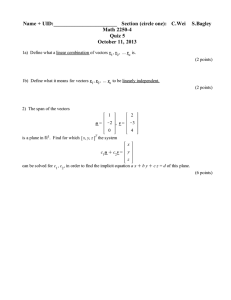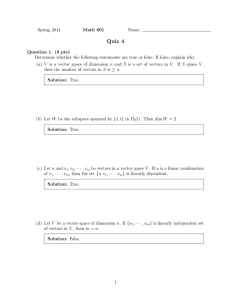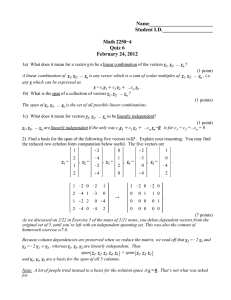Math 2250-4 Mon Oct 21
advertisement
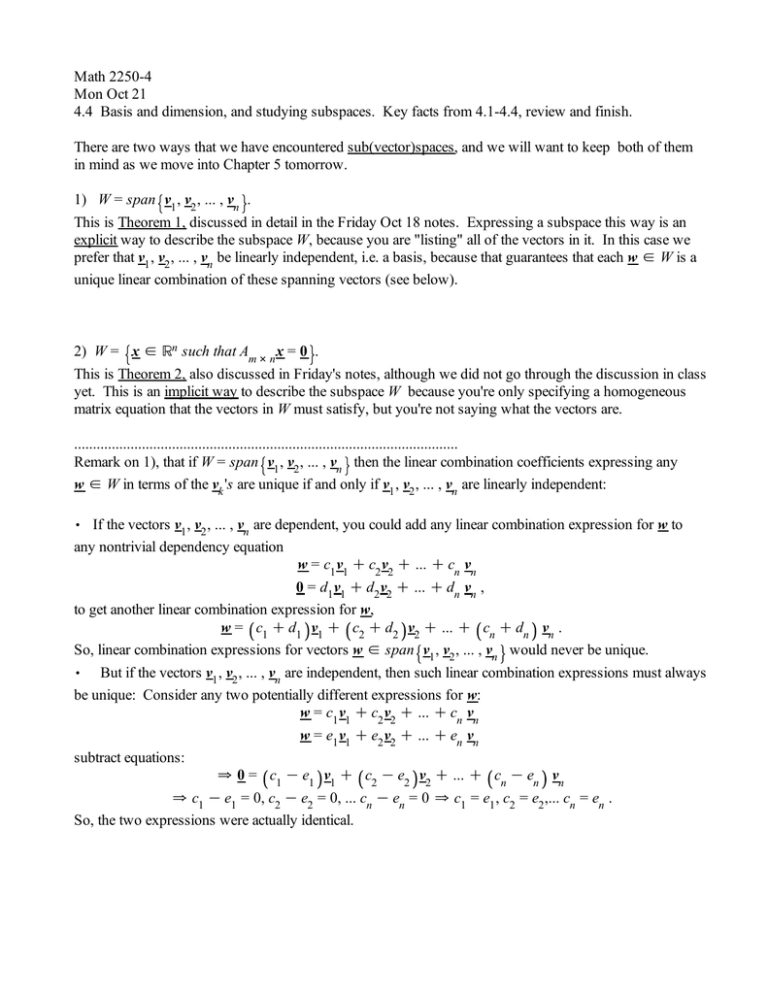
Math 2250-4 Mon Oct 21 4.4 Basis and dimension, and studying subspaces. Key facts from 4.1-4.4, review and finish. There are two ways that we have encountered sub(vector)spaces, and we will want to keep both of them in mind as we move into Chapter 5 tomorrow. 1) W = span v1 , v2 , ... , vn . This is Theorem 1, discussed in detail in the Friday Oct 18 notes. Expressing a subspace this way is an explicit way to describe the subspace W, because you are "listing" all of the vectors in it. In this case we prefer that v1 , v2 , ... , vn be linearly independent, i.e. a basis, because that guarantees that each w 2 W is a unique linear combination of these spanning vectors (see below). 2) W = x 2 =n such that Am # n x = 0 . This is Theorem 2, also discussed in Friday's notes, although we did not go through the discussion in class yet. This is an implicit way to describe the subspace W because you're only specifying a homogeneous matrix equation that the vectors in W must satisfy, but you're not saying what the vectors are. ...................................................................................................... Remark on 1), that if W = span v1 , v2 , ... , vn then the linear combination coefficients expressing any w 2 W in terms of the vk 's are unique if and only if v1 , v2 , ... , vn are linearly independent: , If the vectors v1 , v2 , ... , vn are dependent, you could add any linear combination expression for w to any nontrivial dependency equation w = c1 v1 C c2 v2 C ... C cn vn 0 = d1 v1 C d2 v2 C ... C dn vn , to get another linear combination expression for w, w = c1 C d1 v1 C c2 C d2 v2 C ... C cn C dn vn . So, linear combination expressions for vectors w 2 span v1 , v2 , ... , vn would never be unique. , But if the vectors v1 , v2 , ... , vn are independent, then such linear combination expressions must always be unique: Consider any two potentially different expressions for w: w = c1 v1 C c2 v2 C ... C cn vn w = e1 v1 C e2 v2 C ... C en vn subtract equations: 0 0 = c1 K e1 v1 C c2 K e2 v2 C ... C cn K en vn 0 c1 K e1 = 0, c2 K e2 = 0, ... cn K en = 0 0 c1 = e1 , c2 = e2 ,... cn = en . So, the two expressions were actually identical. Exercise 1a) Use the matrix algebra properties A xCy = A xCA y A cx =cA x to show directly that the homogeneous solution space W = x 2 =n such that Am # n x = 0 in Theorem 2 is closed under addition (α) and scalar multiplication (β), i.e. that it is a subspace. (This is the general case of every homework problem you were assigned in section 4.2, in the cases where the set under consideration turns out to be a subspace.) 1b) For b s 0 Explain why the solution space W = x 2 =n such that Am # n x = b is never a subspace. If we wish to find a basis for the homogeneous solution space W = x 2 =n such that Am # n x = 0 , then the following algorithm will always work: reduce the augmented matrix, backsolve and write the explicit solution in linear combination form. The vectors that you are taking linear combinations of will always span the solution space, by construction. If you follow this algorithm they will automatically be linearly independent, so they will be a basis for the solution space. This is illustrated in the large example below: Exercise 2 Consider the matrix equation A x = 0 , with the matrix A (and its reduced row echelon form) shown below: A := 1 2 0 1 1 2 2 4 1 4 1 7 1 K2 1 K1 K2 1 K2 K4 0 K2 K2 K4 =6 1 2 0 1 / 1 2 0 0 1 2 K1 3 0 0 0 0 0 0 0 0 0 0 0 0 Find a basis for the solution space W = x 2 s.t. A x = 0 by backsolving, writing your explicit solutions in linear combination form, and extracting a basis. Explain why these vectors span the solution space and verify that they're linearly independent. Solution (don't peek :-): backsolve, realizing that the augmented matrices have final columns of zero. Label the free variables with the letter "t", and subscripts to show the non-leading 1 columns from which they arose: x6 = t6 , x5 = t5 , x4 = t4 , x3 =K2 t4 C t5 K 3 t6 x2 = t2 , x1 =K2 t2 K t4 K t5 K 2 t6 . In vector form and then linear combination form this is: x K2 t K t K t K 2 t x t x K2 t C t K 3 t 1 2 4 5 2 3 4 = x 5 t 4 x t x t 5 6 6 2 6 = t 4 K2 K1 K1 K2 1 0 0 0 0 Ct 0 2 5 K2 4 1 Ct 1 0 5 Ct K3 6 0 0 0 1 0 0 0 0 1 . 6 Thus the four vectors K2 K1 K1 K2 1 0 0 0 0 0 , K2 1 , 1 0 K3 , 0 0 0 1 0 0 0 0 1 are a basis for the solution space: , They span the solution space by construction. , They are linearly independent because if we set a linear combination equal to zero: K2 t K t K t K 2 t 2 t 2 K2 K1 K1 K2 0 1 0 0 0 0 0 K2 1 K3 0 0 Ct 4 1 Ct 5 0 Ct 6 0 = = 0 0 0 1 0 0 0 0 0 1 0 4 5 t K2 t C t K 3 t 4 5 t t t 6 2 6 4 5 6 then looking in the second entry implies t2 = 0, the fourth entry implies t4 = 0, and similarly t5 = t6 = 0 . Exercise 3) Focus on the idea that solutions to homogeneous matrix equations correspond exactly to linear dependencies between the columns of the matrix. (If it helps, think of renaming the vector x in the example above, with a vector c of linear combination coefficients; then recall the prime Chapter 4 algebra fact that A c = c1 col1 A C c2 col2 A C...C cn coln A so any solution c to A c = 0 is secretly a columns dependency, and vise-verse.) Now, since the solution set to a homogeneous linear system does not change as you do elementary row operations to the augmented matrix, column dependencies also do not change. Therefore your basis in Exercise 2 for the homogeneous solution space can also be thought of as a "basis" of the key column dependencies, for both the original matrix, and for the reduced row echelon form. 3a) Check this, by reading off "easy" column dependencies in the reduced matrix; seeing that they are also dependencies in the original matrix; and that they correspond to the basis of the homogeneous solution space. Magic! We will use this magic in important interesting ways, later in the course. A := 1 2 0 1 1 2 2 4 1 4 1 7 1 K2 1 K1 K2 1 K2 K4 0 K2 K2 K4 1 2 0 1 / 1 2 0 0 1 2 K1 3 0 0 0 0 0 0 0 0 0 0 0 0 . 3b) Find a basis for W = the span of the five columns of A. Hint: this will be a two-dimensional subspace of =4 and cyou can create it by successively removing redundant (dependent) vectors from the original collection of the five column vectors, until your remaining set still spans W but is linearly independent. Remark: This "magic" connection via the homogeneous solutions space, guaranteeing that column dependencies are the same in a matrix and in its reduced row echelon form explains the mystery of why each matrix has only one reduced row echelon form, no matter which sequence of elementary row operations one uses to compute it. (Did any of you wonder why this was true?) The four conditions for rref (zero rows at bottom, non-zero rows start with leading ones, leading ones in successive rows move to the right, all column entries in any column containing a leading "1" are zero except for that "1"), together with the column dependencies of the original (and hence reduced matrix) uniquely determine the rref matrix. Check with the matrix A we've been using, to see how column dependencies in the original matrix determine the reduced row echelon form. Some important facts about spanning sets, independence, bases and dimension follow from one key fact, and then logic. We will want to use these facts going forward, as we return to studying differential equations tomorrow. key fact: If n vectors v1 , v2 , ... vn span a subspace W then any collection w1 , w2 , ... wN of vectors in W with N O n will always be linearly dependent. (This is explained on pages 254-255 of the text, and has to to do with matrix facts that we already know.) Notice too that this fact fits our intuition based on what we know in the special cases that we've studied, in particular W = =n .) Thus: 1) If a finite collection of vectors in W is linearly independent, then no collection with fewer vectors can span all of W . (This is because if the smaller collection did span, the larger collection wouldn't have been linearly independent after all, by the key fact.) 2) Every basis of W has the same number of vectors, so the concept of dimension is well-defined and doesn't depend on choice of basis. (This is because if v1 , v2 , ... vn are a basis for W then every larger collection of vectors is dependent by the key fact and every smaller collection fails to span by (1), so only collections with exactly n vectors have a chance to be bases.) 3) Let the dimension of W be the number n, i.e. there is some basis v1 , v2 , ... vn for W. Then if vectors w1 , w2 , ... wn span W then they're automatically linearly independent and thus a basis. (If they were dependent we could delete one of the wj that was a linear combination of the others and still have a spanning set. This would violate (1) since v1 , v2 , ... vn are linearly independent.) 4) If the dimension of W is the number n, and if w1 , w2 , ... wn are in W and are linearly independent, then they automatically span W and thus are a basis. (If they didn't span W we could augment with a vector wn C 1 not in their span and have a collection of n C 1 still independent* vectors in W, violating the key fact. ) * Check: If w1 , w2 , ... wn are linearly independent, and wn C 1 ; span w1 , w2 , ... wn , then w1 , w2 , ... wn , wn C 1 are also linearly independent. This fact generalizes the ideas we used when we figured out all possible subspaces of =3 . Here's how it goes: To show the larger collection is still linearly independent study the equation c1 w1 C c2 w2 C ... C cn wn C d wn C 1 = 0 . Since w ; span w1 , w2 , ... wn it must be that d = 0 (since otherwise we could solve for wn C 1 as a linear combination of w1 , w2 , ... wn ). But once d = 0 , we have c1 w1 C c2 w2 C ... C cn wn = 0 which implies c1 = c2 =...= cn = 0 by the independence of w1 , w2 , ... wn . &
